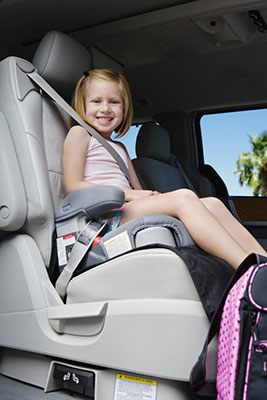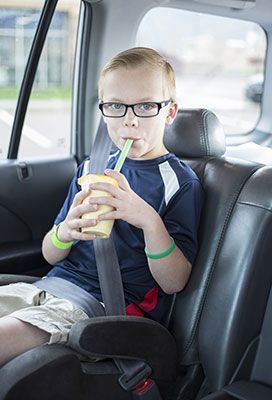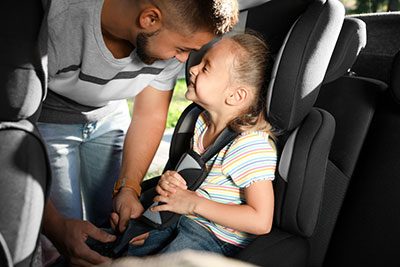Are you the parent of a growing child and wondering what type of car seat is best for them? Have you heard about "belt-positioning booster seats" but aren't sure exactly what they are or if they are the right option to keep your little one safe and secure in the car? Don't worry!
In this blog post, we will review all there is to know what is a belt positioning booster seat so that you can be an informed consumer and make the best car seat choice for you and your family. Read on for our top guide tips on buying a belt-positioning booster seat.
More...
Take Away Key Points:
Table of Contents
- What you need to know about belt-positioning booster seats?
- Belt-positioning booster seat safety tips
- How to choose the best belt-positioning booster?
- What are other booster seat types?
- FAQs
- When can my child use a belt-positioning booster?
- What are the 4 types of booster seats?
- How do you use a belt adjuster booster seat?
- What is the difference between 5-point and 6-point harnesses?
- What is the next step after a 5-point harness?
- How to install Britax Highpoint 2-stage belt-positioning booster car seat?
- Summary
What you need to know about belt-positioning booster seats?
If your children have outgrown their car seats, it's time for a booster seat. But do you know what is a belt-positioning booster and how to use the car seat correctly?
If you don't, please refer to the guidelines below, and learn the best tips when using a booster seat for your little ones.
1. What is a belt-positioning booster car seat?

A belt-positioning booster seat is a safety device created to place an adult seat belt over your child's body. The seat-belt positioning booster seat works by setting the shoulder belt across the child's shoulder, ideally across the collarbone and the child's chest.
In addition, the safety uses the lap belt to cover the child's upper thighs. The lap belt lies low on the child's hips, covering both the thighs and hips.
The vehicle lap and shoulder belts must adequately fit the children to use the belt-positioning boosters. For example, the lap belt must not cover the stomach, while the shoulder belt must not cover the neck.
If the lap and shoulder belts do not fit your child correctly, the children must not use the booster seats. Instead, they must use forward-facing harness car seats.
2. What is the main purpose of the belt-positioning booster car seat?
The main purpose of these booster seats is to ensure maximum safety standards for your children during the entire ride. The booster seats prevent severe injury and even fatal outcomes in a crash. The booster seat will also raise your child to ensure the seat belt fits your little one correctly.
3. Does a belt-positioning booster seat use a vehicle seat belt?
Yes, a belt-positioning seat uses vehicle seat belts to restrain your child. This is the main difference from the harnessed car seats.
The harnessed car seats use the five-point harness system to keep children safe in the car seats. The harness straps keep them stable and secure and prevent unbuckling from the car seat.
On the other hand, the belt-positioning booster uses vehicle seat belts with lap and shoulder belts to restrain your little one. As a result, the child will have more freedom to move. But, using a booster seat requires a proper seat belt fit to avoid injuries and fatal outcomes. So, if your kids are not ready, do not place them into boosters.
4. Is a high-back booster safer than a backless booster?
Both are the both-positioning seats. However, the high-back booster is always safer than the backless booster.
The first option comes with the upper construction offering better head support for your child's head and keeping the child optimal in the back of the vehicle, providing more safety features than the backless model.
The backless booster will not provide as high a standards for using the seat belt as the high back booster, even though the backless model is also safe.
Belt-positioning booster seat safety tips
If you want to keep your child safe in the belt-positioning booster seat, you need to follow these booster seat safety tips:
- Do not place the child in the belt-positioning booster seat if they are not ready for the car seat. Only when they outgrow their harnessed sets can the children use the vehicle seat belts for the boosters.
- Once the child uses the booster seat, they must remain in the back of the vehicle until they are four feet nine inches tall to properly use the seat belt - adult lap and shoulder belt. Children must be between eight and twelve years old to outgrow most booster seats.
- Always use the booster car seat in the back seat of your vehicle, and always with the vehicle lap and shoulder belt.
- Ensure the lap and shoulder belt fit matches your child correctly. The shoulder belt has to cross the chest and shoulder, and the lap belt crosses the hips and upper thighs. They must never cover your child's neck, face, or stomach.
- Never place the shoulder belt behind your child's back or arm in the safety seat. The seat belt will cause harm under the arm, and they will lack safety behind the back.
- Suppose you cannot adjust the vehicle's lap and shoulder belts to fit your booster seat. In that case, various boosters - high-back or backless booster seats- come with seat belt guides or plastic clips to help you adjust the shoulder belt and install the booster seats correctly. If you still cannot adjust the child restraints, use your vehicle's shoulder belt height adjusters.
- If you don't have shoulder belts in the back of your vehicle, ensure the repair shop or car dealer installs them in your back seat, or consider using a travel vest, accommodating children up to 168 pounds.
- The child must be tall enough to sit against the vehicle's back seat with the knees bent without slouching and comfortably stay in such a position throughout the trip.
How to choose the best belt-positioning booster?
To ensure the best booster seat for your little one, you can refer to the following factors:
- Let your child help you choose the best booster seat. Then, take them with you while searching for the best booster restraint, so they can try a few options and choose the best one. Also, teach your children to buckle up properly.
- Ensure the desired booster seat meets FMVSS 213 and NHTSA standards.
- Make sure your child knows the booster will help them see through the window better and wear the seat belt comfortably. However, the boosters are better for older children, not smaller ones. So, please do not push your kids to use them when they are unprepared.
- Explain to your little one why they must use the booster and how they will prevent severe injuries in accidents instead of simply using the vehicle seat belts.
What are other booster seat types?

Here are other types of boosters available for your child's seat:
1. Combination seats: These boosters come with a five-point harness. They are intended for children with a minimum weight of 40 pounds. Then, you can remove the harness, and your child can ride in the belt-positioning booster, working with the adult lap and shoulder belt. Some of such forward-facing seats securely accommodate children up to 100 pounds. So, examine the instruction manual or the label for precise weight or height limits.
2. High-back booster seat and backless booster seat: Both booster types use the vehicle belt system to restrain children. A high-back booster seat is ideal if your vehicle has low seat backs or does not have headrests. But, if you use a high-back booster seat, you might need to move the headrests when they push the boosters forward. On the other hand, the backless booster seat can be used with the vehicle's headrests or high seat backs.
3. Built-in restraints: Some manufacturers have built-in integrated booster seats in the vehicles. Some of these restraints resemble boosters. These can be used as harnessed seats when the children are smaller and as boosters with vehicle seat belts for older kids. But, some vehicles might use only boosters. So, you should consult your vehicle owner's manual for the built-in restraints.
FAQs
When can my child use a belt-positioning booster?
School-aged children are the best users of these boosters. Ideally, they should be at least five years old to use the boosters.
What are the 4 types of booster seats?
The four types of booster seats include: combination seat, backless boosters, high back boosters, built-in restrains (when they are boosters)
How do you use a belt adjuster booster seat?
You must thread the shoulder portion of the belt through the belt adjuster and raise the booster seat's headrest to match the child's height.
What is the difference between 5-point and 6-point harnesses?
Five-point harnesses include two hip/lap straps, two shoulder straps, and one crotch strap. Six-point harness systems include two lap/hip straps, two shoulder straps, and two crotch straps.
What is the next step after a 5-point harness?
After your little one outgrows the five-point harness, it's time for the belt-positioning booster seat.

How to install Britax Highpoint 2-stage belt-positioning booster car seat?
Follow the procedure below:
- Push the seat against the vehicle's seat back and ensure the backrest lies flat
- Extend the lower connector adjuster strap
- Push lower anchors into the adjacent lower connectors
- Pull the connectors to ensure the safe attachment
- Again push the connectors to the anchors and check for the click sound
- Guide your booster into the correct place while pulling the adjuster strap to remove slack
- Shake the seat to see if it's moving more than one inch or not for safe installation
Summary
The belt-positioning booster seat is the best seat for kids aged five and older until they are ready to use seat belts in cars. However, you should not rush if they are not prepared for boosters.
Remember, your kid's safety is your top priority, so follow the rules to ensure the best fit.
